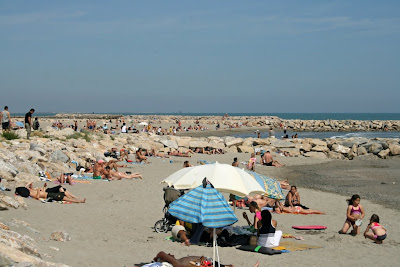This lovely short film is an example of what I like about the new world we're living in. A filmmaker gets to make his or her own film. That's all. There's no one telling him or her what should go into it or be left out of it.
Consequently, the ecosystem of online videos is slowly evolving to include these uniquely quiet and powerful voices.
Which turns out to be a perfect compliment for this film's subject: monk seals. In particular, Mediterranean monk seals, Monachus monachus (Greek monachos: solitary; Latin monachus: monk). The Mediterranean monk seals in this film live far from the Mediterranean on the Atlantic coast of Mauritania, in the region around Cap Blanc, known in Arabic as Ras Nouadhibou. They've survived here against all odds thanks to nearly inaccessible caves�some have entrances only underwater�in inaccessible cliffs on unpeopled coastlines.
This species was well known to the people of the ancient civilizations of the Mediterranean. In his Historia Animalium, Aristotle wrote extensively about wildlife. But he struggled to understand what seals were all about:
The seal is a kind of imperfect or crippled quadruped; for just behind the shoulder-blade its front feet are placed, resembling hands, like the front paws of the bear; for they are furnished with five toes, and each of the toes has three flexions and a nail of inconsiderable size. The hind feet are also furnished with five toes; in their flexions and nails they resemble the front feet, and in shape they resemble a fish's tail.
Aristotle, btw, thought women were deformed men.
Today the Mediterranean monk seal is listed as critically endangered on the IUCN Red List. It's one of the rarest mammals on Earth with less than 500 living individuals. The largest surviving colony had been found, though not easily, in the citadel of the Mauritanian caves. But these holdouts from monks and men were hard hit by a die-off in 1997 that killed 200 of 300 seals. No one's sure why. Maybe a virus. Maybe a toxic algal bloom. They've slowly recovered to about 130 today. Yet the die-off may have reduced their genetic diversity by some 12 percent, to a point where they can't reproduce fast enough to overcome random events that effect survival. The
IUCN notes impressive efforts to save the Mediterranean monk seal:
However, all of the actions have been insufficient to change the overall declining trend of this species. Most conservation initiatives occur only on paper and do not translate into real and effective conservation action in the field. As a consequence, most of the small subpopulations that survived three decades ago, when conservation of the species was already identified as being a priority, are now extinct. Today, human encroachment of haul-out habitat, adverse interactions with fisheries and impoverished genetic variability are the main threats affecting the species. Unless there is urgent action, the extinction risk of the species is high.

The soundtrack of the film is fascinating. Surely these seals were the Sirens who tried to lure sailors to wreck and ruin? Jason and the Argonauts would have died if Orpheus had not been along on the voyage. Hearing the Sirens' songs, Orpheus drew his lyre, played his own exquisite music, and prevented the Argonauts from jumping overboard and drowning. Maybe that's where we get the phrase drowned out.

























